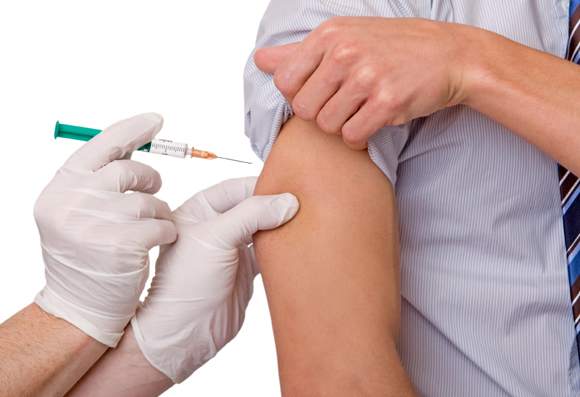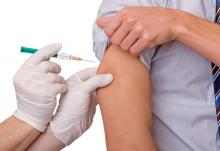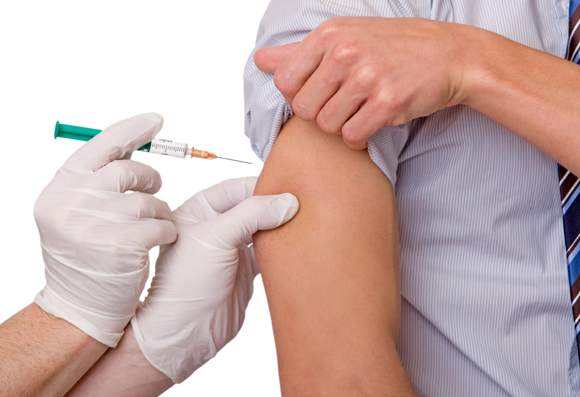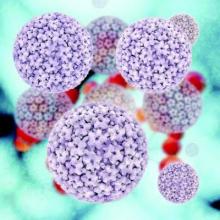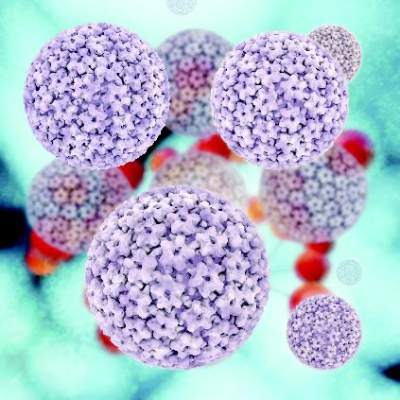User login
2015-2016 flu vaccine 59% effective, CDC says
The overall rate of effectiveness for the 2015-2016 season’s influenza vaccine is 59%, according to preliminary data shared at a Centers for Disease Control and Prevention’s Advisory Committee on Immunization Practices meeting.
“This means that getting a flu vaccine this season reduced the risk of having to go to the doctor because of flu by nearly 60%,” Dr. Joseph Bresee – who heads the CDC’s Epidemiology and Prevention Branch – stated in a press release. “It’s good news and underscores the importance and the benefit of both annual and ongoing vaccination efforts this season.”
These findings are based on data collected by the U.S. Flu Vaccine Effectiveness Network between November 2, 2015, and February 12, 2016. A 59% effectiveness rate would be roughly in line with what previous years’ vaccines have rated when similar strains of influenza have been prevalent, according to the CDC.
Against the H1N1 strain, which was “responsible for most flu illness this season,” the influenza vaccine was 51% effective. Dr. Bresee noted that the CDC has received reports of unvaccinated individuals this season dying or falling seriously ill because of infection from the H1N1 strain.
The vaccine was 76% effective against all influenza B virus strains, and 79% effective against the B/Yamagata virus strains. There are not enough data at this time, however, to determine the vaccine’s effectiveness against B/Victoria or H3N2 strains.
The CDC cautions that, because the current influenza season is still weeks away from being over, the final rate of vaccine effectiveness for 2015-2016 may change once all the data are analyzed. On average, influenza seasons last 13 weeks.
“Flu activity this season started a bit later and has been lower so far than we’ve seen during the previous three seasons, but activity is still on the upswing and expected to continue for several weeks,” Dr. Bresee stated.
The overall rate of effectiveness for the 2015-2016 season’s influenza vaccine is 59%, according to preliminary data shared at a Centers for Disease Control and Prevention’s Advisory Committee on Immunization Practices meeting.
“This means that getting a flu vaccine this season reduced the risk of having to go to the doctor because of flu by nearly 60%,” Dr. Joseph Bresee – who heads the CDC’s Epidemiology and Prevention Branch – stated in a press release. “It’s good news and underscores the importance and the benefit of both annual and ongoing vaccination efforts this season.”
These findings are based on data collected by the U.S. Flu Vaccine Effectiveness Network between November 2, 2015, and February 12, 2016. A 59% effectiveness rate would be roughly in line with what previous years’ vaccines have rated when similar strains of influenza have been prevalent, according to the CDC.
Against the H1N1 strain, which was “responsible for most flu illness this season,” the influenza vaccine was 51% effective. Dr. Bresee noted that the CDC has received reports of unvaccinated individuals this season dying or falling seriously ill because of infection from the H1N1 strain.
The vaccine was 76% effective against all influenza B virus strains, and 79% effective against the B/Yamagata virus strains. There are not enough data at this time, however, to determine the vaccine’s effectiveness against B/Victoria or H3N2 strains.
The CDC cautions that, because the current influenza season is still weeks away from being over, the final rate of vaccine effectiveness for 2015-2016 may change once all the data are analyzed. On average, influenza seasons last 13 weeks.
“Flu activity this season started a bit later and has been lower so far than we’ve seen during the previous three seasons, but activity is still on the upswing and expected to continue for several weeks,” Dr. Bresee stated.
The overall rate of effectiveness for the 2015-2016 season’s influenza vaccine is 59%, according to preliminary data shared at a Centers for Disease Control and Prevention’s Advisory Committee on Immunization Practices meeting.
“This means that getting a flu vaccine this season reduced the risk of having to go to the doctor because of flu by nearly 60%,” Dr. Joseph Bresee – who heads the CDC’s Epidemiology and Prevention Branch – stated in a press release. “It’s good news and underscores the importance and the benefit of both annual and ongoing vaccination efforts this season.”
These findings are based on data collected by the U.S. Flu Vaccine Effectiveness Network between November 2, 2015, and February 12, 2016. A 59% effectiveness rate would be roughly in line with what previous years’ vaccines have rated when similar strains of influenza have been prevalent, according to the CDC.
Against the H1N1 strain, which was “responsible for most flu illness this season,” the influenza vaccine was 51% effective. Dr. Bresee noted that the CDC has received reports of unvaccinated individuals this season dying or falling seriously ill because of infection from the H1N1 strain.
The vaccine was 76% effective against all influenza B virus strains, and 79% effective against the B/Yamagata virus strains. There are not enough data at this time, however, to determine the vaccine’s effectiveness against B/Victoria or H3N2 strains.
The CDC cautions that, because the current influenza season is still weeks away from being over, the final rate of vaccine effectiveness for 2015-2016 may change once all the data are analyzed. On average, influenza seasons last 13 weeks.
“Flu activity this season started a bit later and has been lower so far than we’ve seen during the previous three seasons, but activity is still on the upswing and expected to continue for several weeks,” Dr. Bresee stated.
FROM AN ACIP MEETING
ACIP Recommends LAIV as an Option for All People With Egg Allergies
Live attenuated influenza vaccine (LAIV) is likely to be an option for all individuals with egg allergies, regardless of allergy severity, because the Centers for Disease Control and Prevention’s Advisory Committee on Immunization Practices voted to approve proposed amendments to the existing recommendations regarding administration of LAIV in individuals with egg allergies.
With 11 members voting “yes” and three choosing to abstain, the committee agreed to leave sections 1, 2, and 3 as they currently are, with a slight change to section 1 so that it will now include the latter half of recommendations that were previously placed under section 4. Therefore, section 1 of the recommendations for influenza vaccination of persons with egg allergy – which already states that “Regardless of a recipient’s allergy history, all vaccines should be administered in settings in which personnel and equipment for rapid recognition and treatment of anaphylaxis are available” – will now also include text stating that the vaccine should be administered in a medical setting and supervised by a health care provider with “experience in the recognition and management of severe allergic conditions,” or that such a medical professional should be “immediately available.”
Sections 2 and 3 will remain the same. Section 2 states that a previous allergic reaction to the influenza vaccine is a contraindication to ever receiving the vaccine again in the future. Section 3 states that individuals with egg allergy who have only experienced hives due to eggs still should be administered the influenza vaccine.
The committee voted to strike section 5 of the existing recommendations, which calls for a 30-minute postvaccination observation period. However, the committee still advises that health care providers monitor all patients, particularly adolescents, for 15 minutes immediately after vaccination, and that individuals should be seated or lying down “to decrease the risk for injury should syncopy occur.”
The CDC generally follows ACIP’s recommendations.
Live attenuated influenza vaccine (LAIV) is likely to be an option for all individuals with egg allergies, regardless of allergy severity, because the Centers for Disease Control and Prevention’s Advisory Committee on Immunization Practices voted to approve proposed amendments to the existing recommendations regarding administration of LAIV in individuals with egg allergies.
With 11 members voting “yes” and three choosing to abstain, the committee agreed to leave sections 1, 2, and 3 as they currently are, with a slight change to section 1 so that it will now include the latter half of recommendations that were previously placed under section 4. Therefore, section 1 of the recommendations for influenza vaccination of persons with egg allergy – which already states that “Regardless of a recipient’s allergy history, all vaccines should be administered in settings in which personnel and equipment for rapid recognition and treatment of anaphylaxis are available” – will now also include text stating that the vaccine should be administered in a medical setting and supervised by a health care provider with “experience in the recognition and management of severe allergic conditions,” or that such a medical professional should be “immediately available.”
Sections 2 and 3 will remain the same. Section 2 states that a previous allergic reaction to the influenza vaccine is a contraindication to ever receiving the vaccine again in the future. Section 3 states that individuals with egg allergy who have only experienced hives due to eggs still should be administered the influenza vaccine.
The committee voted to strike section 5 of the existing recommendations, which calls for a 30-minute postvaccination observation period. However, the committee still advises that health care providers monitor all patients, particularly adolescents, for 15 minutes immediately after vaccination, and that individuals should be seated or lying down “to decrease the risk for injury should syncopy occur.”
The CDC generally follows ACIP’s recommendations.
Live attenuated influenza vaccine (LAIV) is likely to be an option for all individuals with egg allergies, regardless of allergy severity, because the Centers for Disease Control and Prevention’s Advisory Committee on Immunization Practices voted to approve proposed amendments to the existing recommendations regarding administration of LAIV in individuals with egg allergies.
With 11 members voting “yes” and three choosing to abstain, the committee agreed to leave sections 1, 2, and 3 as they currently are, with a slight change to section 1 so that it will now include the latter half of recommendations that were previously placed under section 4. Therefore, section 1 of the recommendations for influenza vaccination of persons with egg allergy – which already states that “Regardless of a recipient’s allergy history, all vaccines should be administered in settings in which personnel and equipment for rapid recognition and treatment of anaphylaxis are available” – will now also include text stating that the vaccine should be administered in a medical setting and supervised by a health care provider with “experience in the recognition and management of severe allergic conditions,” or that such a medical professional should be “immediately available.”
Sections 2 and 3 will remain the same. Section 2 states that a previous allergic reaction to the influenza vaccine is a contraindication to ever receiving the vaccine again in the future. Section 3 states that individuals with egg allergy who have only experienced hives due to eggs still should be administered the influenza vaccine.
The committee voted to strike section 5 of the existing recommendations, which calls for a 30-minute postvaccination observation period. However, the committee still advises that health care providers monitor all patients, particularly adolescents, for 15 minutes immediately after vaccination, and that individuals should be seated or lying down “to decrease the risk for injury should syncopy occur.”
The CDC generally follows ACIP’s recommendations.
FROM AN ACIP MEETING
ACIP recommends LAIV as an option for all people with egg allergies
Live attenuated influenza vaccine (LAIV) is likely to be an option for all individuals with egg allergies, regardless of allergy severity, because the Centers for Disease Control and Prevention’s Advisory Committee on Immunization Practices voted to approve proposed amendments to the existing recommendations regarding administration of LAIV in individuals with egg allergies.
With 11 members voting “yes” and three choosing to abstain, the committee agreed to leave sections 1, 2, and 3 as they currently are, with a slight change to section 1 so that it will now include the latter half of recommendations that were previously placed under section 4. Therefore, section 1 of the recommendations for influenza vaccination of persons with egg allergy – which already states that “Regardless of a recipient’s allergy history, all vaccines should be administered in settings in which personnel and equipment for rapid recognition and treatment of anaphylaxis are available” – will now also include text stating that the vaccine should be administered in a medical setting and supervised by a health care provider with “experience in the recognition and management of severe allergic conditions,” or that such a medical professional should be “immediately available.”
Sections 2 and 3 will remain the same. Section 2 states that a previous allergic reaction to the influenza vaccine is a contraindication to ever receiving the vaccine again in the future. Section 3 states that individuals with egg allergy who have only experienced hives due to eggs still should be administered the influenza vaccine.
The committee voted to strike section 5 of the existing recommendations, which calls for a 30-minute postvaccination observation period. However, the committee still advises that health care providers monitor all patients, particularly adolescents, for 15 minutes immediately after vaccination, and that individuals should be seated or lying down “to decrease the risk for injury should syncopy occur.”
The CDC generally follows ACIP’s recommendations.
Live attenuated influenza vaccine (LAIV) is likely to be an option for all individuals with egg allergies, regardless of allergy severity, because the Centers for Disease Control and Prevention’s Advisory Committee on Immunization Practices voted to approve proposed amendments to the existing recommendations regarding administration of LAIV in individuals with egg allergies.
With 11 members voting “yes” and three choosing to abstain, the committee agreed to leave sections 1, 2, and 3 as they currently are, with a slight change to section 1 so that it will now include the latter half of recommendations that were previously placed under section 4. Therefore, section 1 of the recommendations for influenza vaccination of persons with egg allergy – which already states that “Regardless of a recipient’s allergy history, all vaccines should be administered in settings in which personnel and equipment for rapid recognition and treatment of anaphylaxis are available” – will now also include text stating that the vaccine should be administered in a medical setting and supervised by a health care provider with “experience in the recognition and management of severe allergic conditions,” or that such a medical professional should be “immediately available.”
Sections 2 and 3 will remain the same. Section 2 states that a previous allergic reaction to the influenza vaccine is a contraindication to ever receiving the vaccine again in the future. Section 3 states that individuals with egg allergy who have only experienced hives due to eggs still should be administered the influenza vaccine.
The committee voted to strike section 5 of the existing recommendations, which calls for a 30-minute postvaccination observation period. However, the committee still advises that health care providers monitor all patients, particularly adolescents, for 15 minutes immediately after vaccination, and that individuals should be seated or lying down “to decrease the risk for injury should syncopy occur.”
The CDC generally follows ACIP’s recommendations.
Live attenuated influenza vaccine (LAIV) is likely to be an option for all individuals with egg allergies, regardless of allergy severity, because the Centers for Disease Control and Prevention’s Advisory Committee on Immunization Practices voted to approve proposed amendments to the existing recommendations regarding administration of LAIV in individuals with egg allergies.
With 11 members voting “yes” and three choosing to abstain, the committee agreed to leave sections 1, 2, and 3 as they currently are, with a slight change to section 1 so that it will now include the latter half of recommendations that were previously placed under section 4. Therefore, section 1 of the recommendations for influenza vaccination of persons with egg allergy – which already states that “Regardless of a recipient’s allergy history, all vaccines should be administered in settings in which personnel and equipment for rapid recognition and treatment of anaphylaxis are available” – will now also include text stating that the vaccine should be administered in a medical setting and supervised by a health care provider with “experience in the recognition and management of severe allergic conditions,” or that such a medical professional should be “immediately available.”
Sections 2 and 3 will remain the same. Section 2 states that a previous allergic reaction to the influenza vaccine is a contraindication to ever receiving the vaccine again in the future. Section 3 states that individuals with egg allergy who have only experienced hives due to eggs still should be administered the influenza vaccine.
The committee voted to strike section 5 of the existing recommendations, which calls for a 30-minute postvaccination observation period. However, the committee still advises that health care providers monitor all patients, particularly adolescents, for 15 minutes immediately after vaccination, and that individuals should be seated or lying down “to decrease the risk for injury should syncopy occur.”
The CDC generally follows ACIP’s recommendations.
FROM AN ACIP MEETING
Data on two-dose 9-valent HPV vaccinations encouraging, but more needed
Studies of two-dose and three-dose 9-valent human papillomavirus (HPV) vaccines in youth aged 9-14 years and in those up to age 26 found the vaccines to be “generally well tolerated in all vaccination groups,” according to a report at a meeting of the Centers for Disease Control and Prevention’s Advisory Committee on Immunization Practices.
There were no vaccine-related severe adverse events, deaths, or discontinuations due to an adverse event.
The key points for ACIP to consider were the time interval between the first and second vaccine doses, the duration of protection provided by a two-dose regimen, and that it is imperative for patients to complete the entire series of vaccinations. A longer-term follow-up is planned, explained Dr. Alain Luxembourg, who spoke about the studies on behalf of Merck. “9-valent [vaccine] has now been licensed in more than 30 countries, [and] the ACIP recommended gardasil-9 for vaccination in 2015, so we continue to look at further developments in terms of licensure and recommendations,” he said.
The first of two 9vHPV two-dose studies was an open-label trial that examined five cohorts of 300 children; cohorts 1-3 and 5 were of children ages 9-14 years, and cohort 4 – the control – was of children and adults aged 16-26 years. All individuals in cohorts 1, 4, and 5 were female, all children in cohort 2 were male, and cohort 3 comprised males and females.
Children in cohorts 1 and 2 were put on dosing regimens lasting either 0 or 6 months. Children in cohort 3 were placed in regimens lasting either 0 or 12 months, while those in cohorts 4 and 5 were in regimens of either 0, 2, or 6 months. Vaccine administration was done over two or three visits, within a 4-week window of month 6 and month 12; those who were on a 2-month regimen were vaccinated within 3 weeks of reaching 2 months. In addition, one dose of 9vHPV was administered at 36 months to “assess immune memory.”
The second study was a 37-month trial that examined noninferiority of measured geometric mean titer (GMT) concentrations – the metric used for both studies to determine HPV concentration – at 1 month after last dose in both girls and boys who were on a two-dose regimen, and compared them with young women who received a three-dose regimen.
The results indicated that noninferior HPV concentrations at 1 month after administration of the final dose in both girls and boys “supports extending efficacy findings in women who received three doses to girls and boys who received two doses.” Furthermore, lower measure GMTs were found in girls who received only two doses versus three, although Dr. Luxembourg said the clinical significance of this finding is as yet unknown.
Dr. Luxembourg is an employee of Merck.
Studies of two-dose and three-dose 9-valent human papillomavirus (HPV) vaccines in youth aged 9-14 years and in those up to age 26 found the vaccines to be “generally well tolerated in all vaccination groups,” according to a report at a meeting of the Centers for Disease Control and Prevention’s Advisory Committee on Immunization Practices.
There were no vaccine-related severe adverse events, deaths, or discontinuations due to an adverse event.
The key points for ACIP to consider were the time interval between the first and second vaccine doses, the duration of protection provided by a two-dose regimen, and that it is imperative for patients to complete the entire series of vaccinations. A longer-term follow-up is planned, explained Dr. Alain Luxembourg, who spoke about the studies on behalf of Merck. “9-valent [vaccine] has now been licensed in more than 30 countries, [and] the ACIP recommended gardasil-9 for vaccination in 2015, so we continue to look at further developments in terms of licensure and recommendations,” he said.
The first of two 9vHPV two-dose studies was an open-label trial that examined five cohorts of 300 children; cohorts 1-3 and 5 were of children ages 9-14 years, and cohort 4 – the control – was of children and adults aged 16-26 years. All individuals in cohorts 1, 4, and 5 were female, all children in cohort 2 were male, and cohort 3 comprised males and females.
Children in cohorts 1 and 2 were put on dosing regimens lasting either 0 or 6 months. Children in cohort 3 were placed in regimens lasting either 0 or 12 months, while those in cohorts 4 and 5 were in regimens of either 0, 2, or 6 months. Vaccine administration was done over two or three visits, within a 4-week window of month 6 and month 12; those who were on a 2-month regimen were vaccinated within 3 weeks of reaching 2 months. In addition, one dose of 9vHPV was administered at 36 months to “assess immune memory.”
The second study was a 37-month trial that examined noninferiority of measured geometric mean titer (GMT) concentrations – the metric used for both studies to determine HPV concentration – at 1 month after last dose in both girls and boys who were on a two-dose regimen, and compared them with young women who received a three-dose regimen.
The results indicated that noninferior HPV concentrations at 1 month after administration of the final dose in both girls and boys “supports extending efficacy findings in women who received three doses to girls and boys who received two doses.” Furthermore, lower measure GMTs were found in girls who received only two doses versus three, although Dr. Luxembourg said the clinical significance of this finding is as yet unknown.
Dr. Luxembourg is an employee of Merck.
Studies of two-dose and three-dose 9-valent human papillomavirus (HPV) vaccines in youth aged 9-14 years and in those up to age 26 found the vaccines to be “generally well tolerated in all vaccination groups,” according to a report at a meeting of the Centers for Disease Control and Prevention’s Advisory Committee on Immunization Practices.
There were no vaccine-related severe adverse events, deaths, or discontinuations due to an adverse event.
The key points for ACIP to consider were the time interval between the first and second vaccine doses, the duration of protection provided by a two-dose regimen, and that it is imperative for patients to complete the entire series of vaccinations. A longer-term follow-up is planned, explained Dr. Alain Luxembourg, who spoke about the studies on behalf of Merck. “9-valent [vaccine] has now been licensed in more than 30 countries, [and] the ACIP recommended gardasil-9 for vaccination in 2015, so we continue to look at further developments in terms of licensure and recommendations,” he said.
The first of two 9vHPV two-dose studies was an open-label trial that examined five cohorts of 300 children; cohorts 1-3 and 5 were of children ages 9-14 years, and cohort 4 – the control – was of children and adults aged 16-26 years. All individuals in cohorts 1, 4, and 5 were female, all children in cohort 2 were male, and cohort 3 comprised males and females.
Children in cohorts 1 and 2 were put on dosing regimens lasting either 0 or 6 months. Children in cohort 3 were placed in regimens lasting either 0 or 12 months, while those in cohorts 4 and 5 were in regimens of either 0, 2, or 6 months. Vaccine administration was done over two or three visits, within a 4-week window of month 6 and month 12; those who were on a 2-month regimen were vaccinated within 3 weeks of reaching 2 months. In addition, one dose of 9vHPV was administered at 36 months to “assess immune memory.”
The second study was a 37-month trial that examined noninferiority of measured geometric mean titer (GMT) concentrations – the metric used for both studies to determine HPV concentration – at 1 month after last dose in both girls and boys who were on a two-dose regimen, and compared them with young women who received a three-dose regimen.
The results indicated that noninferior HPV concentrations at 1 month after administration of the final dose in both girls and boys “supports extending efficacy findings in women who received three doses to girls and boys who received two doses.” Furthermore, lower measure GMTs were found in girls who received only two doses versus three, although Dr. Luxembourg said the clinical significance of this finding is as yet unknown.
Dr. Luxembourg is an employee of Merck.
FROM AN ACIP MEETING



